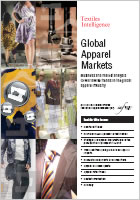Issue
8:
4th Quarter 2009

Product Overview
Buy this Report now
Buy this Issue now
Subscribe
Download brochure (PDF)
Download price list (PDF)
Price list download
| Please choose your preferred currency:
|
Request sample issue
View list of reports
in other issues
|
Multi Report Package |
We also offer a flexible subscription product,
the Multi Report Package,
which allows you to select your own choice of reports from our full range,
to suit your own budget.
Click here for full details.
|
|
 |
Technological developments in the clothing industry |

17 pages,
published in Issue 8, 4th Quarter 2009
Report price:
Euro 395.00;
US$ 520.00
|
Recent technological developments in clothing production equipment have centred around machinery for knitting, linking, pleating, decorating and embroidering. In particular, new computerised flat knitting machines have enabled knitwear to be created in one piece without the need for linking or sewing. In linking, an intelligent machine has been developed which features an easy-to-use screen and an intelligent camera. In pleating, a Japanese machine has been invented which takes the physical strain out of the pleating process. In decorating, Barudan has produced a machine which makes it possible to cross-seam embroidery on the legs of finished jeans for the first time. TPM Germany has launched a machine which can perform many printing and finishing operations, while several companies have developed special systems for lasering patterns on to jeans. In embroidery, Barudan has introduced one of the first triple combination machines, Brother has developed a machine which allows appliqué to be attached at the same time as mainstream embroidery, and Koma-Tech has invented a machine to produce three-dimensional fuwari embroidery.
In the area of electronic textiles, Fraunhofer IZM and TU Berlin have developed an interactive dress which is able to ?translate? movements of the body into visual patterns of light by using electronic stretchable circuit boards. King?s Metal Fiber Technologies and AiQ Smart Clothing have jointly produced garments which utilise specially developed electronics for lighting, sound, heating, solar panel recharging and body monitoring. And G24 Innovations has introduced dye-sensitised thin-film solar cells, which provide enough power for smart textiles to be used effectively in garments.
In the field of anti-counterfeiting technology, a number of companies have introduced ?textile DNA?. Schoeller Technologies has developed DNAtex?a unique code which can be applied to chemicals, fibres, fabrics and finished products and identified by using a scanner?and Amann has launched Blue Sky Technology, a treatment which enables sewing thread to be identified using a laser pen.
In other areas, Shapely Shadow has launched a new form of mannequin?called RealForms?which can be moulded by an item of clothing, thus enabling observers to see the effect which tight clothing has on the skin. Smartfiber has developed SeaCell active plus, a health enhancing cellulose fibre. Inocatec has developed Inocatex, a patch of material designed to be incorporated into the gusset of women?s panties to alleviate premenstrual pain and eliminate odour, and HT Concept has developed Reflect Line Gold, a waterproof breathable temperature-regulating polyurethane membrane which also provides stability.
- Technological developments in the clothing industry
-
- Summary
- Clothing production machinery
- Electronic textiles for futuristic clothing designs
- Anti-counterfeiting ?DNA?
- Realistic mannequin from Shapely Shadow
- Health-enhancing algae for sportswear, workwear, underwear and hosiery
- Underwear which provides relief from menstrual pain
| Global Apparel Markets provides intelligence, analysis and insight on the global apparel industry. |  | What's in it?
Each issue contains: essential information on trade and trade policy; news from leading brands, companies and other organisations; analysis of key geographical markets; and expert opinions on strategy. A single issue of Global Apparel Markets includes:  practical and strategic advice from industry experts practical and strategic advice from industry experts  a report on a key geographical market a report on a key geographical market  a round-up of the latest product innovations a round-up of the latest product innovations  a feature on trade and trade policy a feature on trade and trade policy  comprehensive information on the latest business developments comprehensive information on the latest business developments
An annual subscription to Global Apparel Markets is a cost-effective way to keep informed about trends and developments in the global apparel industry. Subscriptions are available in printed and/or digital formats. Printed and digital subscribers receive each issue in printed format in addition to a digital PDF file, which is available immediately on publication. Subscribers also receive a complementary digital subscription to Global Apparel Update, delivered directly by email once a month. This free supplement contains essential information on business news and the latest product developments. Like all Textiles Intelligence publications, Global Apparel Markets is a reliable source of independently sourced business information, and it does not carry advertising.
| This is what our customers say: |
"In our work, we were looking for industry insights and trends - who the major suppliers were, which countries were producing and what, productivity rates, investment incentives, where investors were moving to and why, etc. A lot of the individual country case studies you did were great - I remember one recently on the UK for example. There was also a great article from a guy on the Turkish market and recent trends there. Both these articles were written for the layman so they were easy to understand but comprehensive at the same time.
The technology articles were also interesting.
Basically, it was an all-round good publication that covered everything in enough depth so that you would always find something of interest in each issue." |
| (Alan J. Saffery; Competitiveness, Private Sector & Economic Growth ; Saffery Consulting) |
|
|
 |
